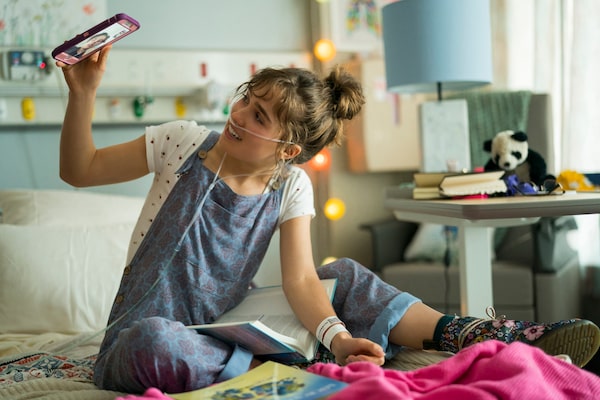
Haley Lu Richardson as Stella Grant and Cole Sprouse as Will Newman in Five Feet Apart, an Entertainment One release.Alfonso Bresciani/Entertainment One
Oh, leave the kids alone. All this tsuris about Sick Lit and Sick Flicks – the young-adult genre in which teenagers confront illness, death, suicide, depression and/or self-harm; and the inevitable films made from said novels – is ridiculous.
If young people want to pony up for a film about two teenagers with cystic fibrosis who fall in love even though it may make them sicker – Five Feet Apart, opened last week, stars spunky Haley Lu Richardson and broody Cole Sprouse, already grossed US$14-million – what’s the harm?
If they want to watch a streaming series about a girl who kills herself, leaving behind a box of audiotapes hinting at why (13 Reasons Why, huge hit on Netflix, Season 3 coming soon); or a film about a young man paralyzed in a motorcycle accident and the new love who may help him end his life (Me Before You, came out in 2016, earned US$56-million); or a film about a suicidal teen who checks himself into a psych ward, where he learns life lessons from Zach Galifianakis (It’s Kind of a Funny Story, which kind of bombed, grossing only US$6-million and change) – just let them.
Instead, there’s this avalanche of think – and I use that term advisedly – pieces about how dangerous and scary these books/films are. Take the hit YA novel Before I Die, which sold 70,000 copies in four months, and was made into a film called Now Is Good, starring Dakota Fanning. A girl with cancer wants to have sex before she dies. There were pundits who decried this, because it might (gasp) encourage teenagers to want to have sex.
There was similar breast-beating over To the Bone, a Netflix film starring Lily Collins that depicted anorexia realistically; and By the Time You Read This I’ll Be Dead, a YA novel in which a character consults a suicide website; or Sharp Objects (both a Gillian Flynn novel and an HBO miniseries starring Amy Adams), in which the main character is a cutter.

Five Feet Apart is a film about two teenagers with cystic fibrosis who fall in love even though it may make them sicker.Alfonso Bresciani/Entertainment One
Newsflash, pundits: Teenagers are going to have sex. Some will be bulimic or anorexic, or have suicidal ideation, or will cut. In those cases, the last thing you need to worry about is a novel or film. There’s a whole internet full of sites that – horrifyingly, to be sure – advocate that stuff. YA novels and the films made from them might dig deep into those subjects, and might even have empathy for them. But they’re also going to show readers/viewers the characters’ thought processes, and offer alternatives. Often, they’ll spark public conversations, and be accompanied by websites where they encourage young people to seek help. Mainly, they’re going to make readers/watchers feel like they’re not alone, and that might make them feel less hopeless. Reading a YA novel is far from the worst thing a teenager can do alone in her room.
After all, these stories abound because they speak to an essential truth about the first 20 years of human life: It’s dramatic. Ever since Juliet stabbed herself, every teenager has felt like they might die any minute. (I call it hormone poisoning.) For many years, that feeling manifested itself in novels and films where teenagers turned into werewolves or vampires, or fell in love with werewolves and vampires. Then in 2012, The Fault in Our Stars came out.
Centred on a girl with thyroid cancer who falls for a fellow patient, it topped Amazon’s YA bestseller list for six months; the 2014 film, starring Shailene Woodley and Ansel Elgort, raked in over US$300-million around the world, though it cost only US$12-million to make. (That’s another reason these films are so popular with studios: Young actors are cheaper.)
Some people point to 2012 as the moment the Sick Lit/Flick genre took off. There was 2014’s If I Stay, about a girl in a coma (Chloe Grace Moretz) whose thoughts we hear as she ponders death. And 2015’s Me, Earl and the Dying Girl, about two boys who make films to amuse their ailing friend. And 2017’s Everything, Everything, about a girl confined to her home (Amandla Stenberg) who falls for the boy next door. And 2017’s The Big Sick, based on the true story of the comedian Kumail Nanjiani, his wife, Emily Gordon, and her mysterious illness.
But the truth is, this genre is always with us: The Perks of Being a Wallflower (2012), A Walk to Remember (2002), Moulin Rouge! (2001), Little Women (1994), starring Claire Danes (spoiler: Beth dies), newly hot on its 25th anniversary, because Greta Gerwig is about to remake it yet again.
Julia Roberts starred in a Sick Flick (Dying Young); so did Anne Hathaway and Jake Gyllenhaal (Love & Other Drugs), Charlize Theron and Keanu Reeves (Sweet November), Richard Gere and Winona Ryder (Autumn in New York – her autumn, not his). Jane Campion directed one, Bright Star, about John Keats; Gus Van Sant and Sofia Coppola did, too (Restless and The Virgin Suicides, respectively). And who can forget the immortal first line of the 1970 novel and film Love Story – book dropped on Valentine’s Day, tens of millions sold, translated into 20 languages; film arrived in December, people lined up around the block, remains one of the highest grossers of all time – “What can you say about a 25-year-old girl who died?”
It’s hardly surprising that today’s teenagers are obsessed with pain, illness and death. First, it’s teenagers who bear the brunt of internet shaming, FOMO pressure, and the nausea caused by feeling too connected yet too disconnected, simultaneously. Second, I thought high school would kill me, but that was nothing; Today’s kids are getting killed just by attending high school. Third and most crucially, even more than previous generations, today’s teens know they’re going to die, because they are staring down an actual, scientific deadline: 20 years to fix climate change or the planet implodes.
It’s teenagers who organized last week’s school walkout to stress the urgency of climate change. Teenagers who led the mourning for the recent massacre in New Zealand. Teenagers who are protesting the United States’ insanely lax gun laws.
So a few million of them are going to a movie where the heroine sits alone in a room, communicating with her bestie only via her laptop? Where she reminds them, “We need human touch from the one we love, almost as much as we need air to breathe”? Where she hears the clock of her life ticking? Where she’ll risk anything to feel something?
I say, give them a pack of tissues and the money to see it again. This genre isn’t going anywhere. Today’s teenagers have a lot to cry about.
 Johanna Schneller
Johanna Schneller